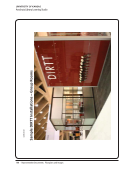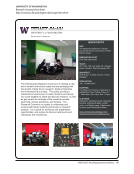20 · Survey Results: Executive Summary
each). While respondents indicated that only one ad-
ditional branch would open and 12 would close within
the next three years, they anticipate 16 consolidations
and 11 other reconfigurations.
Conclusion
This survey investigated recent trends in service point
reconfigurations in main libraries and branch librar-
ies, the driving factors behind the changes, the impact
such changes had on personnel, opportunities for user
participation in the projects, the associated benefits
and challenges, and future plans for anticipated addi-
tions, closures, consolidations, and other reconfigura-
tions during the next three year.
The most common reconfigurations are the con-
solidated service point, the information commons,
the consolidated/central research desk, and virtual-
izations of many kinds. Virtualizations are exciting
to consider as brand new innovations and perhaps
harbingers of service point reconfigurations to come.
Additionally, science branch library closures, in par-
ticular, seemed to out-number other branch library
closures and may reflect the easy electronic dissemi-
nation of journal literature in the sciences.
Philosophical changes appear to be the most im-
portant drivers for service delivery reconfigurations,
followed by user demands. Interestingly, respondents
noted that a change in service philosophy often ac-
companied a physical change such as consolidation
of a service desk or the creation of an information
commons, emphasizing the new method in which the
service is provided.
The impact of service delivery reconfigurations
on staff is considerable. Because staff often don’t have
continuing appointments in the same way tenured
librarians might, they are in the most vulnerable po-
sitions for elimination or reassignment. Although
there are benefits to the mixing of staff from various
service points, including the sharing of expertise and
elimination of silos, respondents noted that training
is a significant challenge.
According to the respondents, the level of user
engagement in each project varied because some of
the reconfigurations were mandated by physical or
financial situations beyond the control of the library.
Several of the respondents described imaginative and
creative methods for obtaining user’s views and sug-
gestions. Although some of the reconfigurations were
too new to assess, most libraries have determined a
strategy for assessment over time.
Given the breadth and depth of the types of re-
configurations described by survey respondents, it is
obvious that ARL libraries have become dynamic mi-
crocosms proactively responding to the needs of their
environments. In these days when the death of the
research library is bandied about more than ever, it is
refreshing to note that libraries such as those respond-
ing to this survey are continuing to strive to provide
the materials and services their constituents require.
Libraries, and particularly ARL member libraries,
have always been in the forefront of applying new
techniques and technologies to provide better service
to their users. The responses to this survey indicate
that is still the case, now more than ever.
Endnotes
1 Reitz, Joan M. Dictionary for Library and Information
Science. Westport, CT: Libraries Unlimited, 2004),
p. 653. (Also online at ODLIS Online Dictionary
for Library and Information Science
http://www.abc-clio.com/ODLIS/odlis_A.aspx
2 p. 102.
3 p. 172.
4 p. 596.
each). While respondents indicated that only one ad-
ditional branch would open and 12 would close within
the next three years, they anticipate 16 consolidations
and 11 other reconfigurations.
Conclusion
This survey investigated recent trends in service point
reconfigurations in main libraries and branch librar-
ies, the driving factors behind the changes, the impact
such changes had on personnel, opportunities for user
participation in the projects, the associated benefits
and challenges, and future plans for anticipated addi-
tions, closures, consolidations, and other reconfigura-
tions during the next three year.
The most common reconfigurations are the con-
solidated service point, the information commons,
the consolidated/central research desk, and virtual-
izations of many kinds. Virtualizations are exciting
to consider as brand new innovations and perhaps
harbingers of service point reconfigurations to come.
Additionally, science branch library closures, in par-
ticular, seemed to out-number other branch library
closures and may reflect the easy electronic dissemi-
nation of journal literature in the sciences.
Philosophical changes appear to be the most im-
portant drivers for service delivery reconfigurations,
followed by user demands. Interestingly, respondents
noted that a change in service philosophy often ac-
companied a physical change such as consolidation
of a service desk or the creation of an information
commons, emphasizing the new method in which the
service is provided.
The impact of service delivery reconfigurations
on staff is considerable. Because staff often don’t have
continuing appointments in the same way tenured
librarians might, they are in the most vulnerable po-
sitions for elimination or reassignment. Although
there are benefits to the mixing of staff from various
service points, including the sharing of expertise and
elimination of silos, respondents noted that training
is a significant challenge.
According to the respondents, the level of user
engagement in each project varied because some of
the reconfigurations were mandated by physical or
financial situations beyond the control of the library.
Several of the respondents described imaginative and
creative methods for obtaining user’s views and sug-
gestions. Although some of the reconfigurations were
too new to assess, most libraries have determined a
strategy for assessment over time.
Given the breadth and depth of the types of re-
configurations described by survey respondents, it is
obvious that ARL libraries have become dynamic mi-
crocosms proactively responding to the needs of their
environments. In these days when the death of the
research library is bandied about more than ever, it is
refreshing to note that libraries such as those respond-
ing to this survey are continuing to strive to provide
the materials and services their constituents require.
Libraries, and particularly ARL member libraries,
have always been in the forefront of applying new
techniques and technologies to provide better service
to their users. The responses to this survey indicate
that is still the case, now more than ever.
Endnotes
1 Reitz, Joan M. Dictionary for Library and Information
Science. Westport, CT: Libraries Unlimited, 2004),
p. 653. (Also online at ODLIS Online Dictionary
for Library and Information Science
http://www.abc-clio.com/ODLIS/odlis_A.aspx
2 p. 102.
3 p. 172.
4 p. 596.






















































































































































































































